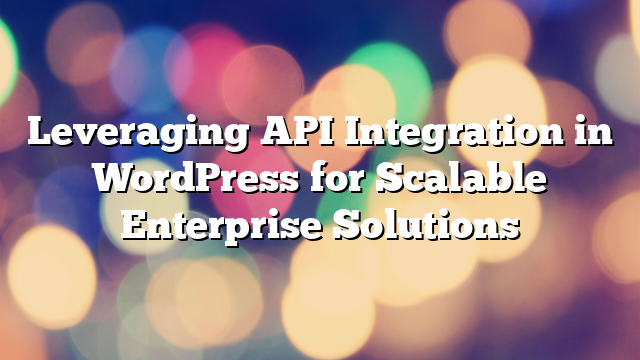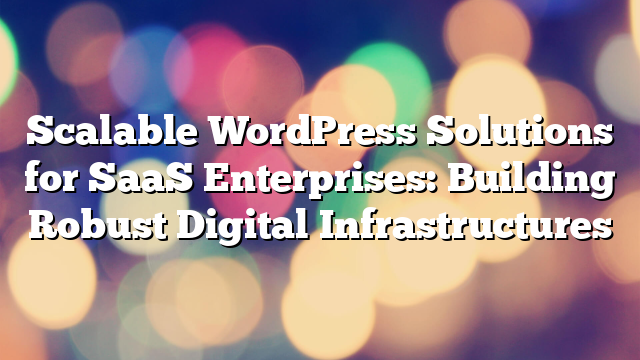Leveraging API Integration in WordPress for Scalable Enterprise Solutions
14.12.2024

In the evolving digital landscape, enterprises rely on robust, scalable, and flexible systems to stay competitive. WordPress, traditionally seen as a blogging platform, has grown into a versatile content management system (CMS) capable of powering complex enterprise applications. By leveraging API integration, enterprises can connect WordPress with other tools, systems, and platforms, creating a seamless and scalable ecosystem. In this article, we’ll explore how API integration enhances WordPress for enterprise use.
What is API Integration in WordPress?
An API (Application Programming Interface) allows different software systems to communicate and exchange data. WordPress provides the REST API and supports third-party APIs, making it a powerful platform for integration. With API integration, WordPress can act as a central hub, connecting various applications and services for streamlined operations.
Benefits of API Integration for Enterprises
1. Enhanced Functionality
API integration extends WordPress’s capabilities beyond its core features. Enterprises can integrate with CRMs, ERPs, marketing tools, and e-commerce platforms, creating a unified workflow that caters to diverse business needs.
2. Seamless Data Exchange
APIs enable real-time data exchange between WordPress and external systems. This ensures consistency and accuracy, allowing enterprises to make data-driven decisions without manual intervention.
3. Scalable Solutions
As enterprises grow, their digital ecosystems become more complex. API integration allows WordPress to scale effortlessly, accommodating new tools and platforms without disrupting existing workflows.
4. Improved User Experience
By integrating with APIs, enterprises can deliver personalized and dynamic content experiences to users. For example, connecting WordPress with a recommendation engine can tailor content suggestions based on user behavior.
5. Automation and Efficiency
APIs facilitate automation by connecting WordPress to tools like Zapier or Integromat. This reduces repetitive tasks and boosts efficiency, freeing teams to focus on strategic initiatives.
6. Multichannel Content Delivery
With API integration, WordPress can serve as a headless CMS, delivering content to various platforms such as mobile apps, IoT devices, and digital kiosks. This ensures consistent branding and messaging across channels.
Key Use Cases for WordPress API Integration
1. E-Commerce Integration
Enterprises can integrate WordPress with platforms like Shopify, WooCommerce, or BigCommerce via APIs. This enables seamless product management, inventory synchronization, and streamlined checkout processes.
2. CRM Integration
Connecting WordPress with CRMs like Salesforce or HubSpot allows enterprises to track customer interactions, generate leads, and manage campaigns directly from their website.
3. Marketing Automation
API integration with tools like Mailchimp or Marketo automates email marketing, segmentation, and analytics, enhancing customer engagement and retention strategies.
4. ERP Integration
Integrating with ERP systems such as SAP or Microsoft Dynamics centralizes business processes, including supply chain management, accounting, and human resources, ensuring operational efficiency.
5. Analytics and Reporting
APIs can connect WordPress to analytics platforms like Google Analytics or Tableau, providing comprehensive insights into user behavior, website performance, and ROI.
Challenges of API Integration in WordPress
1. Complexity in Implementation
API integration requires technical expertise, especially for custom or large-scale projects. Enterprises must ensure they have skilled developers or partner with experienced agencies to handle implementation.
2. Security Concerns
APIs expose endpoints that can be vulnerable to attacks if not secured properly. Enterprises must implement best practices, such as token-based authentication and encryption, to protect their data.
3. Maintenance and Updates
As APIs evolve, maintaining compatibility and ensuring seamless updates can be challenging. Regular audits and proactive monitoring are essential to avoid disruptions.
4. Performance Issues
Improperly optimized APIs can slow down website performance. Enterprises must ensure efficient API design and utilize caching mechanisms to mitigate potential bottlenecks.
Best Practices for API Integration in WordPress
1. Choose the Right API
Select APIs that align with your enterprise’s goals and integrate seamlessly with WordPress. Evaluate documentation, support, and scalability before implementation.
2. Secure Your API Connections
Implement robust security measures, such as SSL certificates, API keys, and rate limiting, to protect sensitive data and prevent unauthorized access.
3. Optimize API Calls
Reduce latency by minimizing the number of API calls and optimizing data requests. Use asynchronous processing where possible to improve performance.
4. Test Thoroughly
Conduct rigorous testing to ensure API integrations work as intended. Test for functionality, performance, and security to identify and resolve issues before deployment.
5. Monitor and Maintain
Set up monitoring tools to track API performance and detect anomalies. Regularly update integrations to stay compatible with changes in API versions.
Conclusion
API integration transforms WordPress into a powerful tool for enterprises, enabling seamless connectivity and scalability. Whether it’s enhancing functionality, automating workflows, or delivering personalized user experiences, the possibilities are endless. By following best practices and addressing potential challenges, enterprises can unlock the full potential of WordPress API integration.
Looking to implement API integration in WordPress for your enterprise? Contact AllWebDev today to discover customized solutions tailored to your needs.



